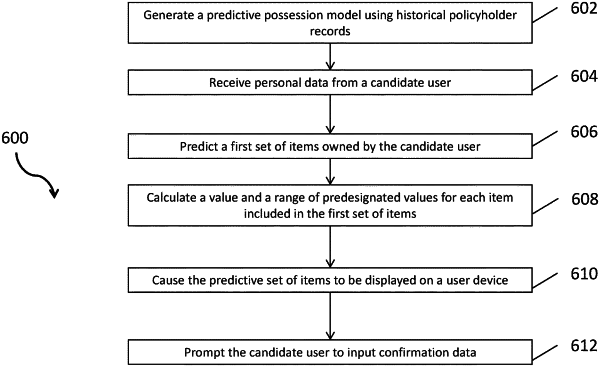| CPC G06Q 40/08 (2013.01) [G06F 16/9535 (2019.01); G06Q 30/0278 (2013.01)] | 17 Claims |

|
1. A computing system for generating a list of items predicted to be associated with a user, the computing system including one or more processors in communication with at least one memory device, the one or more processors configured to:
generate a predictive possession model based at least in part upon a plurality of historical policyholder records associated with a plurality of policyholders,
wherein:
the predictive possession model includes a machine learning model;
the predictive possession model is trained using the plurality of historical policyholder records;
the plurality of historical policyholder records include one or more historical insurance claims that includes one or more items owned by the plurality of policyholders and personal data associated with the plurality of policyholders;
receive personal data associated with the user;
predict, by the generated predictive possession model, a first set of items owned by the user based at least in part upon the received personal data associated with the user, wherein the generated predictive possession model is configured to extract data associated with the first set of items from the received personal data;
assign, by the generated predictive possession model, a value and a range of predesignated values for each item included in the first set of items;
for each item included in the first set of items,
cause information indicative of each item, the assigned value for each item, and the range of predesignated values for each item to be displayed on a user device of the user;
prompt the user to adjust one or more values assigned to the first set of items;
receive an adjusted value for a first item in the first set of items;
determine whether the adjusted value is outside of the range of predesignated values assigned to the first item;
if the adjusted value is within the range of predesignated values assigned to the first item, accept the adjusted value without prompting the user to provide documentation;
if the adjusted value is outside of the range of predesignated values assigned to the first item, prompt the user to provide documentation that verifies the adjusted value of the first item;
receive the documentation that verifies the adjusted value of the first item; and
re-train the generated predictive possession model using the adjusted value of the first item.
|